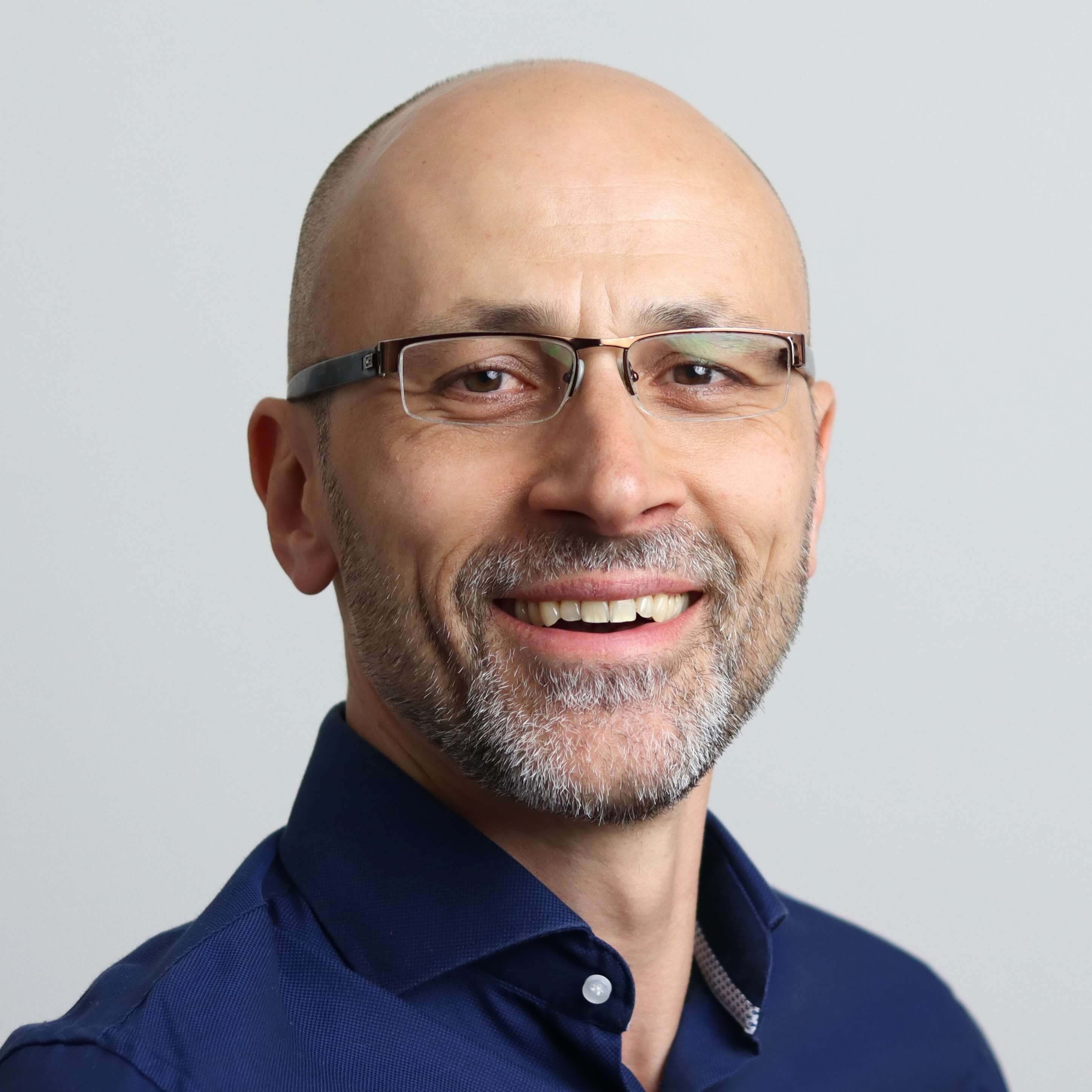Who Owns Novo Nordisk: The Largest Shareholders Overview
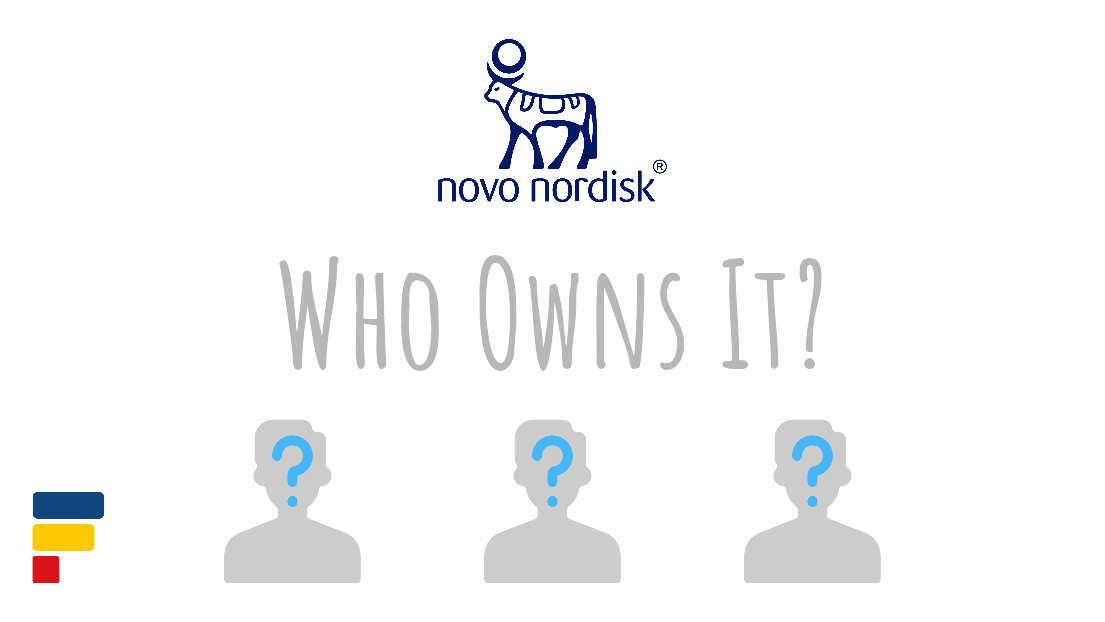
Novo Nordisk A/S (CPH:NOVO-B.CO) is a Danish pharmaceutical company. The company’s main focus and how it makes money are different products focused on diabetes treatment. These include both traditional insulin-based products and also modern treatments like Ozempic and Rybelsus. Let’s now look at who owns Novo Nordisk and who controls it.
Novo Nordisk’s largest and dominant shareholder is Novo Nordisk Foundation, which owns 28.4% share. However, thanks to his “super-voting” shares, Novo Nordisk Foundation controls Novo Nordisk with 77.3% of all votes.
|
|
|||
| Shareholder | Ownership | Voting Power | |
|---|---|---|---|
| Novo Nordisk Foundation | 28.4% | 77.3% | |
| Other | 71.6% | 22.7% | |
| Listed are shareholders holding >5% of any share class or notable in other ways | |||
 Source: Annual Report Source: Annual Report |
|||
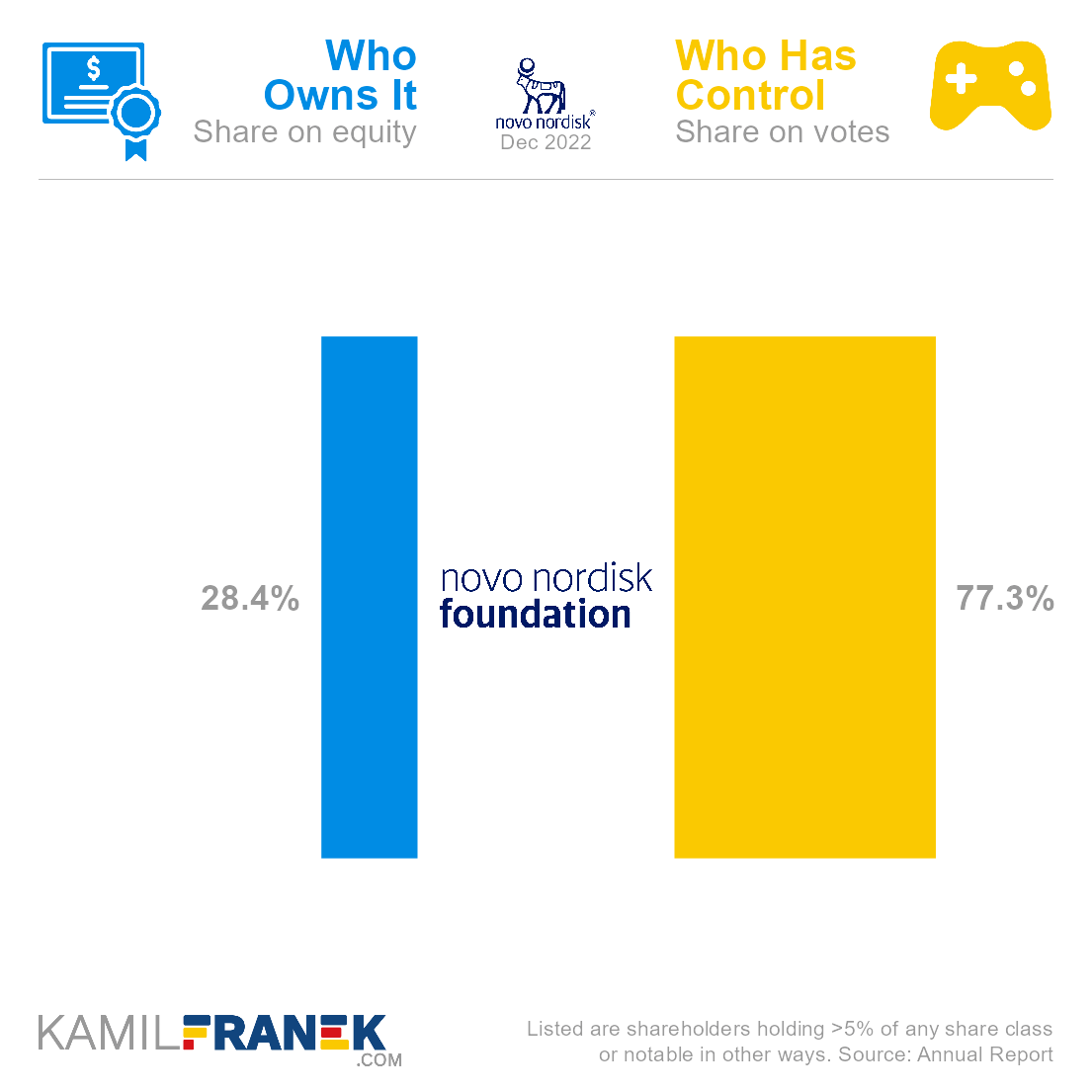
In this article, I will dive more into who owns Novo Nordisk and who controls it. I will show you who Novo Nordisk’s largest shareholders are, how many shares and votes they have, and how much their stake is worth.
If you are interested, you can also explore who owns other companies like Eli Lilly, Johnson & Johnson, Tesla, and other articles in my “Who Owns Who” series.
📃 Who Owns Novo Nordisk?
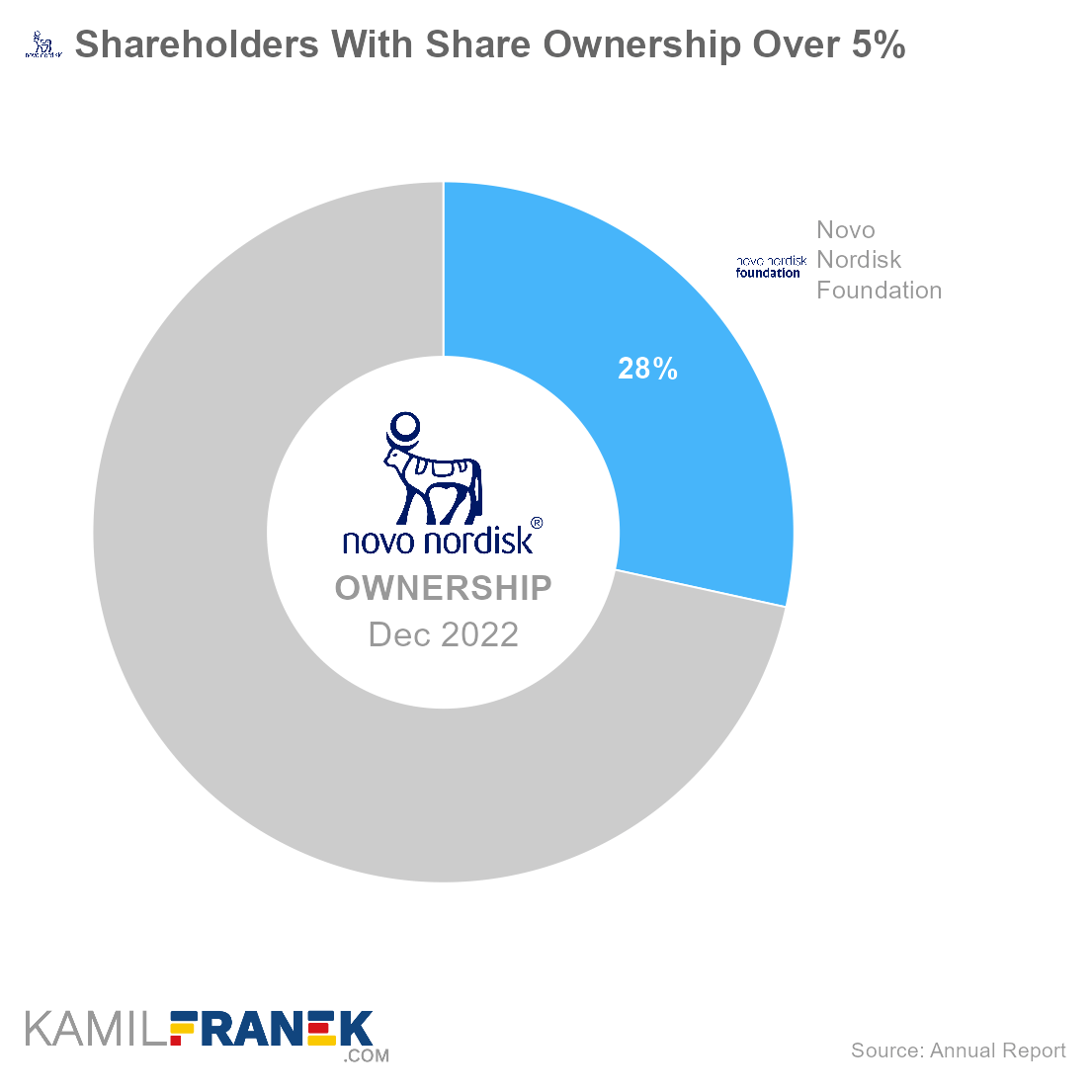
Novo Nordisk is predominantly owned by Novo Nordisk Foundation, which owns 28.4% of the company. However, thanks to the existence of “super-voting” shares, Novo Nordisk Foundation controls 77.3% of Novo Nordisk.
- Novo Nordisk Foundation owns Novo Nordisk A/S through its subsidiary Novo Holdings A/S which manages its funds.
- Novo Nordisk Foundation is the largest charitable foundation in the world based on its endowment portfolio size.
- Novo Nordisk Foundation also controls Novozymes A/S and invests in many other companies, especially in life sciences.
Novo Nordisk was founded in 1923 by August Krogh and Hans Christian Hagedorn and is currently traded on Copenhagen Stock Exchange under ticker CPH:NOVO-B.CO.
- Soon after Novo Nordisk was founded in 1923 in Denmark as “Nordisk” to produce and sell insulin in the Nordic countries, former employees set up a competing “Novo” company that also started producing insulin. Both companies became fierce competitors until they merged in 1989 into Novo Nordisk.
- Novo Nordisk shares are primarily listed on Nasdaq Copenhagen, but its ADRs are traded on NYSE under ticker NVO.
Novo Nordisk A/S is incorporated in Denmark, and its headquarters are in Bagsværd, Denmark.
🎮 Who Controls Novo Nordisk (CPH:NOVO-B.CO)?
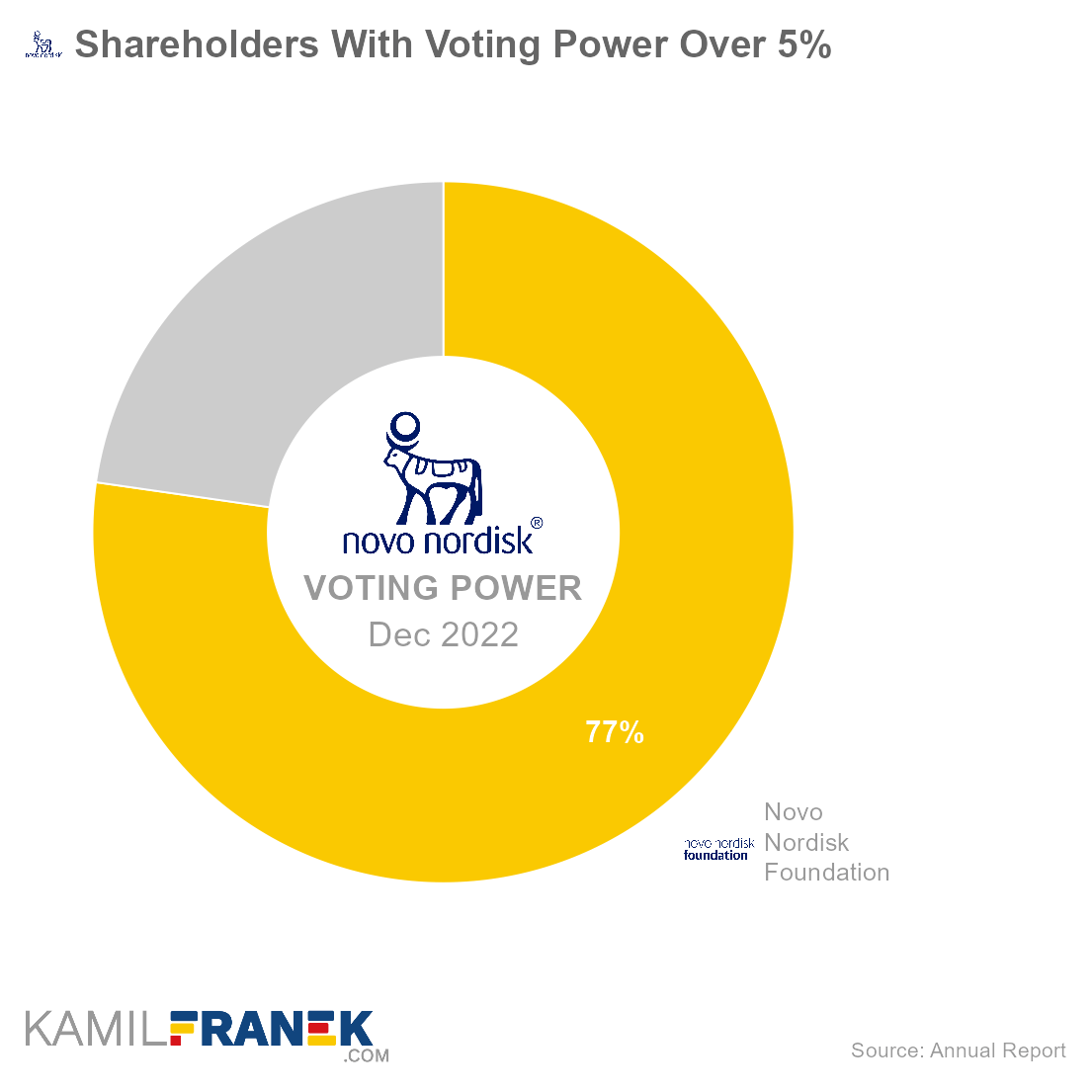
Novo Nordisk is fully controlled by the Novo Nordisk Foundation, which holds 77.3% of all votes. Novo Nordisk Foundation has control mainly thanks to super-voting shares that they hold. Their share of equity is just 28.4%.
The voting power is not equal to ownership. The reason why the main shareholder has outsized voting power compared to their ownership stake is that Novo Nordisk A/S has two classes of outstanding shares with different rights.
- Class A shares are not publicly traded and have 10x the voting power of Class B shares. They are all owned by Novo Nordisk Foundation.
- Class B shares are “normal” shares traded on stock exchanges.
Novo Nordisk’s insiders that have influence over the company are CEO Lars Fruergaard Jørgensen, chairman of the board Helge Lund, and other board members and executives.
- Novo Nordisk has a 12-member board that is re-elected annually.
- However, since the company is controlled by Novo Nordisk Foundation, the biggest power is held by the 10-member board of directors of the Novo Nordisk Foundation.
🗳️ Breakdown of Novo Nordisk’s Outstanding Shares and Votes by Top Shareholders
Novo Nordisk A/S had a total of 2,250 million outstanding shares as of December 2022. The following table shows how many shares each Novo Nordisk’s large shareholder holds.
|
|
|||||
| In millions of shares as of December 2022 | |||||
| Shareholder | Class A | Class B | Total | % Share | |
|---|---|---|---|---|---|
| Novo Nordisk Foundation | 537 | 102 | 640 | 28.4% | |
| Other | - | 1,610 | 1,610 | 71.6% | |
| Total (# millions) | 537 | 1,712 | 2,250 | 100.0% | |
| Listed are shareholders holding >5% of any share class or notable in other ways | |||||
 Source: Annual Report Source: Annual Report |
|||||
There were 141,736 million votes distributed among shareholders of Novo Nordisk A/S. The table below shows the total number of votes for each large shareholder.
|
|
|||||
| In millions of votes as of December 2022 | |||||
| Shareholder | Class A | Class B | Total | % Share | |
|---|---|---|---|---|---|
| Novo Nordisk Foundation | 107,487 | 2,042 | 109,529 | 77.3% | |
| Other | - | 32,207 | 32,207 | 22.7% | |
| Total (# millions) | 107,487 | 34,249 | 141,736 | 100.0% | |
| Listed are shareholders holding >5% of any share class or notable in other ways | |||||
 Source: Annual Report Source: Annual Report |
|||||
💵 Breakdown of Novo Nordisk’s Market Value by Shareholder
The following table summarizes how much is each shareholder’s stake in Novo Nordisk A/S worth.
However, keep in mind that a stake in Novo Nordisk could be just one part of their portfolio, and their total worth could be bigger, thanks to other investments. It could also be lower if they have debts.
|
|
|||||
| Market value in billions $ as of December 2022 | |||||
| Shareholder | Class A | Class B | Total | % Share | |
|---|---|---|---|---|---|
| Novo Nordisk Foundation | $72.3 | $13.7 | $86.0 | 28.4% | |
| Other | - | $216.6 | $216.6 | 71.6% | |
| Total ($ billions) | $72.3 | $230.3 | $302.6 | 100.0% | |
| Listed are shareholders holding >5% of any share class or notable in other ways | |||||
 Source: Annual Report Source: Annual Report |
|||||
Let’s now look at each Novo Nordisk shareholder individually.
📒 Who Are Novo Nordisk’s Largest Shareholders?
Let’s now go through the list of the largest shareholders of Novo Nordisk A/S one by one and look at who they are, how many shares they own, what is their voting power, and how much is their stake in Novo Nordisk worth.
#1 Novo Nordisk Foundation (28.4%)
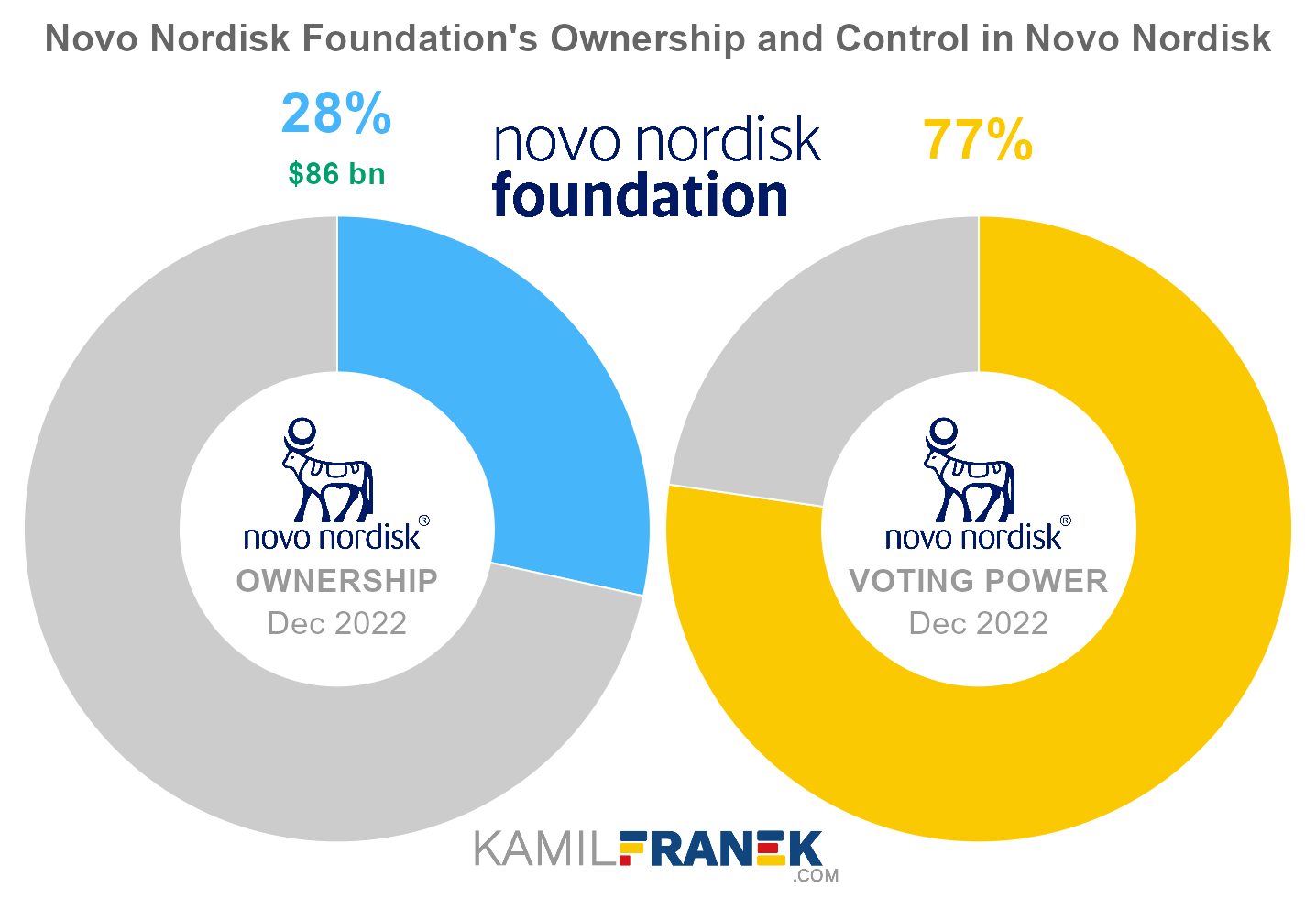
Novo Nordisk Foundation is the largest shareholder of Novo Nordisk, owning 28.4% of its shares. However, Novo Nordisk Foundation controls 77.3% of all votes thanks to owning super-voting shares. As of December 2022, the market value of Novo Nordisk Foundation’s stake in Novo Nordisk was $86.0 billion.
Novo Nordisk Foundation owned 640 million shares in Novo Nordisk and controlled 109,529 million shareholder votes as of December 2022.
Novo Nordisk Foundation is the largest charitable foundation in the world, with a portfolio worth EUR 108 billion. Its history goes back to 1926 when Nordisk Insulin Foundation was founded by Nordisk company.
A significant milestone occurred in 1989 when the Novo and Nordisk companies merged, uniting their respective foundations into the formidable Novo Nordisk Foundation.
Novo Nordisk Foundation is the controlling shareholder of Novo Nordisk A/S and Novozymes A/S through its subsidiary Novo Holdings A/S. Besides those two companies, it invests in many other companies and is a world-leading life sciences investor.
🧱 Who and When Founded Novo Nordisk?
Novo Nordisk has an exciting history. It was founded in 1923 in Denmark as “Nordisk” to produce and sell insulin in the Nordic countries after its co-founder August Krogh obtained permission from Professor Macleod to manufacture insulin in Nordic countries.
However, after a few years, former employees set up a competing “Novo” company that also started to produce insulin too. Both companies became fierce competitors until they merged in 1989 into Novo Nordisk.
Novo Nordisk was the brainchild of August Krogh, a distinguished professor at the University of Copenhagen, and his wife, Marie Krogh.
August Krogh, a Nobel laureate in physiology, had embarked on a lecture tour across the United States to share his medical research.
It was during this journey that the Kroghs became captivated by reports of insulin’s transformative effects on individuals who have diabetes. Marie Kroghs suffered from type 2 diabetes too.
Kroghs reached out to Professor Macleod in Toronto, Canada, who had been involved in the production of the first insulin extract. In December 1922, armed with permission to manufacture and distribute insulin in Scandinavia, the couple returned to Copenhagen.
Thus, in 1923, Nordisk Insulinlaboratorium was established, with August Krogh and Hans Christian Hagedorn at the helm, producing the first Scandinavian insulin product marketed as “Leo.”
However, their efforts did not go unchallenged. Former employees of Nordisk, Harald, and Thorvald Pedersen, initiated their own enterprise, Novo Terapeutisk Laboratorium, in 1925. Novo began manufacturing “Insulin Novo,” thrusting the two companies into a fierce rivalry that would span several decades.
In 1938, both companies engaged in a legal battle as Hagedorn alleged that Novo had utilized a patented method of manufacturing ZPI insulin originally developed by Nordisk. After a contentious legal dispute, Hagedorn emerged victorious in the Supreme Court by a slender margin. This verdict entitled Nordisk to a portion of the revenue generated by Novo from ZPI sales.
However, in 1989, both companies made a groundbreaking decision to merge, forming Novo Nordisk A/S, becoming the world’s largest insulin manufacturer, among other things.
📅 Novo Nordisk’s History Timeline
These are selected events from Novo Nordisk’s history:
Nordisk (1922 - 1989)
- 1922: Danish professor August Krogh received permission to produce insulin in the Nordic countries after visiting the US with his wife Marie, who had type 2 diabetes.
- 1923: Nordisk Insulinlaboratorium founded. August Krogh and Hans Christian Hagedorn started producing the first Scandinavian insulin product, marketed as Leo.
- 1925: Brothers Harald and Thorvald Pedersen, former Nordisk employees, formed their own company, Novo Terapeutisk Laboratorium, and started producing “Insulin Novo.” Novo and Nordisk competed vigorously until they merged in 1989 to become Novo Nordisk A/S.
- 1926: Nordisk Insulin Foundation was established to provide financial support for scientific purposes.
- 1938: Hagedorn claimed that Novo was making ZPI insulin using a method patented by Nordisk. The Pedersen brothers won the first round, but Hagedorn appealed to the Supreme Court and won his case by a majority of one. Nordisk was entitled to a share of the money earned by Novo from sales of ZPI.
- 1983: Nordisk markets an insulin pump called Nordisk Infuser.
- 1986: Nordisk introduces its Insuject device to the market.
- 1986: Nordisk Gentofte’s shares are listed on the Copenhagen Stock Exchange.
- 1989: Nordiject, a pen device with which patients could inject themselves with growth hormone, was launched by the company.
Novo (1925 - 1989)
- 1925: Brothers Harald and Thorvald Pedersen, who were former employees of Nordisk, formed their own company, Novo Terapeutisk Laboratorium, and established a rudimentary production facility in the basement of Harald’s home in Copenhagen, producing a stable, commercially viable solution called “Insulin Novo.”. Novo and Nordisk competed vigorously until they merged in 1989 to become Novo Nordisk A/S.
- 1931: Production demands required the Pedersens to leave their cellar and rent space in a former dairy factory.
- 1935: Thorvald and Harald Pedersen marketed insulin with adrenaline, which used a substance that had been shown to prolong the effect of insulin. The product was soon discontinued because it turned out not to have the desired effect.
- 1938: Novo marketed Zinc-protamine-insulin (ZPI) product, which was developed by two Canadian researchers, D. A. Scott, and A. M. Fisher. It only had to be shaken before injection.
- 1938: Hagedorn claimed that Novo was making ZPI insulin using a method patented by Nordisk. The brothers won the first round, but Hagedorn appealed to the Supreme Court and won his case by a majority of one. Nordisk was entitled to a share of the money earned by Novo from sales of ZPI.
- 1941: Novo introduced its first enzyme product for industrial use.
- 1943: Novo begins experiments with the fermentation of penicillin.
- 1947: Novo introduces Penicillin Novo, the company’s first product made by fermentation.
- 1951: The Novo Foundation was established.
- 1951: Novo launched Heparin Novo, which was used to prevent blood clots.
- 1953: Novo was able to present the Lente products, which for several years covered nearly a third of the world’s insulin consumption.
- 1960: Novo accidentally found a remarkable enzyme with all the properties detergent manufacturers were looking for. The new enzyme product was named Alcalase and became Novo’s first detergent enzyme produced by fermentation.
- 1970: A campaign in the United States to expose alleged health hazards for users of enzymes brought Novo under harsh criticism.
- 1971: Novo developed a dust-free enzyme product to reduce the risk of allergies, and the US Food and Drug Administration concluded that detergent enzymes presented no risk to consumers, leading to an increase in sales figures.
- 1973: Nordisk markets Nanormon growth hormone for the treatment of growth hormone insufficiency.
- 1974: Novo’s B shares are introduced on the Copenhagen Stock Exchange.
- 1979: Novo completed an enzyme factory in North Carolina for the production of fructose sugar.
- 1981: Novo becomes the first Scandinavian company to introduce its shares on the New York Stock Exchange.
- 1982: Human Monocomponent insulin is launched - the world’s first insulin preparation identical to human insulin.
- 1985: NovoPen is launched - an injection system similar in appearance to a fountain pen, with replaceable insulin cartridges.
- 1986: Novo took over the Danish pharmaceutical company Ferrosan A/S. This strengthened Novo’s field of research into developing pharmaceuticals to treat diseases of the central nervous system.
- 1987: Novo starts production of human insulin with the help of genetically engineered yeast cells.
Novo Nordisk (1989 - Now)
- 1989: Nordisk and Novo merged under the name of Novo Nordisk, becoming the world’s leading manufacturer of insulin.
- 1989: The Novo Nordisk Foundation was established by the merger of the Nordisk Insulin Foundation and the Novo Foundation.
- 1992: Antidepressant Seroxat (Paxil) was introduced.
- 1994: Novo Nordisk divested its penicillin business to concentrate on the group’s core businesses.
- 1994: Novo Nordisk acquired a 50% market share in industrial enzymes, particularly for detergents.
- 1995: The Danish Haemophilia Society brought a civil action against the Ministry of the Interior, the National Board of Health, and Nordisk.
- 1995: Epilepsy treatment Gabitril and NovoSeven clotting drugs are introduced.
- 2000: NovoLog, a fast-acting insulin product to challenge Lilly’s Humalog.
- 2000: Health Care (Novo A/S) and Enzyme Business (Novozymes A/S) split from parent company Novo Nordisk A/S and become independent legal entities controlled by Novo Nordisk Foundation.
- 2000: Mads Øvlisen retires from the position of President and CEO of Novo Nordisk A/S and is replaced by Lars Rebien Sørensen.
- 2002: ZymoGenetics is spun off.
- 2003: Norditropin NordiFlex is launched – the world’s first prefilled growth hormone pen.
- 2010: Novo Nordisk launches NovoPen Echo, a new insulin pen developed especially for children.
- 2012: Novo Nordisk developed semaglutide for diabetes therapy. I was sold under the brand name “Ozempic” and later became one of the biggest money makers for the company.
- 2017: The injectable version of Ozempic was approved for use by people with diabetes in the United States and in January 2018 in Canada.
- 2019: Semaglutide version that can be taken orally was approved in the US and in 2020 also in the EU. The company started selling it as Rybelsus.
📚 Recommended Articles & Other Resources
Who Owns Apple: The Largest Shareholders Overview
Visual overview of who owns Apple and who controls it. With a list of the largest shareholders and how much is each of their stake worth.
Who Owns Starbucks: The Largest Shareholders Overview
Overview of who owns Starbucks and who controls it. With a list of the largest shareholders and how much is each of their stake worth.
Who Owns Paypal: The Largest Shareholders Overview
Overview of who owns PayPal and who controls it. With a list of the largest shareholders and how much is each of their stake worth.
Who Owns eBay: The Largest Shareholders Overview
Overview of who owns eBay and who controls it. With a list of the largest shareholders and how much is each of their stake worth.
Who Owns Tesla: The Largest Shareholders Overview
Overview of who owns Tesla and who controls it. With a list of the largest shareholders and how much is each of their stake worth.
Who Owns LVMH: The Largest Shareholders Overview
Overview of who owns LVMH and who controls it. With a list of the largest shareholders and how much is each of their stake worth.
Other Resources
Disclaimer: Although I use third-party trademarks and logos in this article and its visuals, kamilfranek.com is an independent site, and there is no relationship, sponsorship, or endorsement between this site and the owners of those trademarks.

